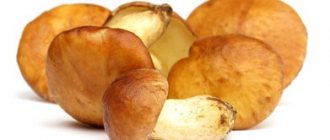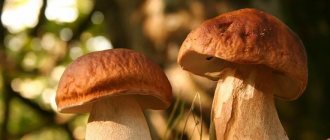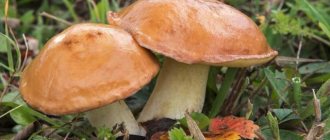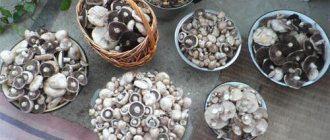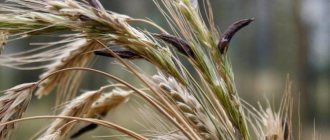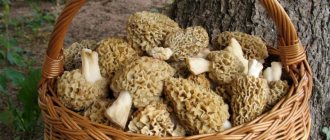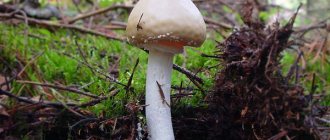The end of summer and the beginning of autumn is mushroom picking season. During the mushroom season, city sanitary and epidemiological services often record situations of mushroom poisoning
.
Even mushroom pickers with many years of experience are not protected from this trouble. In the Russian Federation there are about 70 species of inedible mushrooms, 20 of which have strong toxic properties. Poisoning a person with mushrooms often ends in death, so the main thing is to recognize the first painful symptoms in a timely manner, and also quickly provide medical care to the victim.
Deadly toxic mushroom species
Many toxic species of mushrooms can cause severe intoxication of the body with a fatal outcome. Deadly toxic mushrooms are:
- death cap;
- red fly agaric;
- porphyry fly agaric;
- toadstool fly agaric;
- mountain gossamer;
- whitish talker;
- rough umbrella;
- entoloma is dangerous;
- Lepiota chestnut.
At the moment, the toxicity of certain types of mushrooms has not yet been fully studied by mycologists.
Fly agarics
0
Source:
The mushroom with a red cap and characteristic light spots is just one species of a large genus. Most of them are simply inedible, and some are deadly. The above-mentioned red fly agaric is sometimes taken as an accessible hallucinogen drug, but even its repeated digestion does not exclude severe effects as a result. The symptoms are in many ways similar to those that appear after eating a toadstool, only the required amount of the fruiting body differs - you can eat a little more fly agarics (not half a leg, but a whole mushroom). Amanita mushrooms can be confused with some types of edible mushrooms, especially if there was heavy rain before collection and washed away stains from the cap.
Common symptoms of mushroom poisoning
- Damage to the gastrointestinal tract is expressed as constant vomiting, abdominal pain and severe diarrhea.
- Damage to the central nervous system appears as hallucinations and motor excitation, which is replaced by a process of inhibition and indifference. Symptoms depend on the variant of the toxic fungus.
- Damage to the vascular-cardiac system is accompanied by a decrease in arterial pressure and the formation of tachycardia.
- Damage to the kidneys and liver leads to a decrease in the amount of urine, the formation of hepatodepression and renal failure.
Signs of poisoning by toadstool
Dangerous poisons are concentrated in the pale grebe: phallion, amanitin, phalloidin, which have a toxic effect on the cells of the gastrointestinal tract and are concentrated in the liver cells, then the poisons are transported to all human systems and internal organs. Just 30 mg of toadstool to kill a person. No type of heat treatment can stop the venoms of the toadstool .
Mushroom pickers often mistake pale toadstools for champignons and even russula.
The first symptoms of toadstool poisoning appear only 8-36 hours after consumption. At the first stage of mushroom poisoning, a sick person has:
- headache, which is accompanied by severe chills;
- profuse sweating;
- dizziness;
- weakness;
- abdominal pain;
- constant vomiting;
- diarrhea with blood clots;
- strong feeling of thirst.
Within 24 hours, the above symptoms of poisoning may disappear for a couple of hours and then reappear.
On the second or third day after poisoning, the patient experiences symptoms of renal failure and hepatosuppression:
- liver enlargement;
- yellowness of the eyeballs;
- low blood pressure;
- lack of urination.
Afterwards the person falls into a comatose state. Intoxication with toadstool is fatal in 80% of cases.
Poisonous mushrooms and their poisons
The main causes of poisoning are ignorance of the differences between edible and poisonous mushrooms and carelessness when collecting “forest meat”. Sometimes you can get poisoned by eating large quantities of quite good edible mushrooms (this is dangerous for people suffering from diseases of the gastrointestinal tract or liver), as well as overripe, old fruiting bodies in which decay products have accumulated.
People knew about the poisonous properties of some mushrooms many centuries ago. Historians testify that poisonous mushrooms became a formidable weapon in the struggle for power in the hands of court intriguers. This weapon worked flawlessly: poisoning occurred suddenly, and doctors were powerless to help. This is how the Roman Emperor Claudius, Pope Clement VII, the French King Charles VI and others died, a great lover of mushroom dishes.
About 80 species of poisonous mushrooms grow in Europe, of which about 20 are very poisonous. They grow from early spring to late autumn.
The nature of poisoning depends on the chemical composition of poisonous mushrooms. Most poisonous mushrooms cause mild, short-term illnesses, the most common of which are gastrointestinal disorders. However, some types of poisonous mushrooms cause severe poisoning and death. It should be noted that the consequences of mushroom poisoning depend, in addition to the type of mushroom, also on the age and health status of the victim, and the number of mushrooms eaten. Correct treatment is possible only with an accurate identification of the type of poisonous mushroom.
To facilitate the task of providing immediate assistance, clinical toxicology examines the following main syndromes (groups of symptoms) characteristic of acute poisoning with poisonous mushrooms.
Syndrome of impaired consciousness. It is caused by the direct effect of the poison on the cerebral cortex, as well as the cerebral circulatory disorders and oxygen deficiency caused by it.
Breathing disorder syndrome. Often observed in comatose states, when the respiratory center is depressed. Respiratory disorders also arise due to paralysis of the respiratory muscles, which sharply complicates the course of poisoning. Severe respiratory dysfunction is observed with toxic pulmonary edema and airway obstruction.
Blood damage syndrome. It is characterized by inactivation of hemoglobin and a decrease in the oxygen capacity of the blood.
Circulatory disorder syndrome. Almost always accompanies acute poisoning. The causes of dysfunction of the cardiovascular system can be: inhibition of the vasomotor center, dysfunction of the adrenal glands, increased permeability of the walls of blood vessels, etc.
Thermoregulation disorder syndrome. It is observed in many poisonings and is manifested by a decrease or increase in body temperature. These changes in the body are a consequence, on the one hand, of a slowdown in metabolic processes and increased heat transfer, and, on the other, of the absorption of toxic tissue breakdown products into the blood and disorders of the oxygen supply to the brain.
Convulsive syndrome. As a rule, it is an indicator of severe or extremely severe poisoning. Seizures occur as a result of acute oxygen starvation of the brain or as a result of the specific effect of poisons on the central nervous structures.
Syndrome of mental disorders. Characteristic of poisoning with poisons that selectively act on the central nervous system.
Liver and kidney damage syndrome. Accompanies many types of intoxication, in which these organs become objects of direct exposure to poisons or suffer due to the influence of toxic metabolic products and decay of tissue structures on them.
Syndrome of water-electrolyte balance and acid-base balance. In acute poisoning, it is mainly a consequence of dysfunction of the digestive and excretory systems, as well as secretory organs. In this case, dehydration of the body, disruption of redox processes in tissues, and accumulation of under-oxidized metabolic products are possible.
As already noted, when affecting the body in different quantities, the same substance causes different effects. The minimum effective, or threshold, dose (concentration) of a toxic substance is the smallest amount of it that causes obvious but reversible changes in life activity. The minimum toxic dose is a much larger amount of poison, causing severe poisoning with a complex of characteristic pathological changes in the body, but without death. The stronger the poison, the closer the minimum effective and minimum toxic doses are. In addition to those mentioned, in toxicology it is also customary to consider lethal doses and concentrations of poisons, i.e. those quantities that lead a person (or animal) to death in the absence of treatment. Lethal doses are determined through animal experiments. In experimental toxicology, the average lethal dose (DL50) or concentration (CL50) of poison is most often used, at which 50% of experimental animals die. If 100% of their death is observed, then such a dose or concentration is designated as absolute lethal (DL100 and CL100). Toxicity (toxicity) is determined by the reciprocal of DL50 (CL50): 1/DL50(1/CL50).
Based on the nature of the effects of poisonous mushrooms on humans, they can be divided into three groups.
The first consists of mushrooms with a local stimulating effect. Most poisonous mushrooms in this group cause mild poisoning, mainly gastric and intestinal disorders. Such poisonings include nausea, abdominal pain, sweating, weakness, vomiting, diarrhea, and sometimes fainting. Symptoms of poisoning appear 1-2 hours after eating mushrooms. This group includes some species of the genus Agaricus: yellow-skinned champignon (A. xanthodermus Gen.), variegated champignon (A. meleagris (J. Schaeff.) Imbach), Meller's champignon (A. moelleri S. Wasser); some species of the genus Tricholoma: white-brown row (T. albobrunnea Quel.), brindle row (T. pardinum Quel.), destructive row (T. pessundatum (Fr.) Quel.), yellowish-gray entoloma (Entoloma lividum Quel. ). This also includes the trumpet (Lactarius torminosus Fr.), some types of russula, etc., which are edible only after boiling for 10-15 minutes (pour out the broth!).
The second group consists of mushrooms with a pronounced effect on the nerve centers. This includes mushrooms containing toxic substances, mainly muscarine and muscaridine. Symptoms of poisoning appear 0.5-4 hours after eating mushrooms. Signs of poisoning are severe nausea, vomiting, diarrhea, dizziness, loss of consciousness, increased sweating, bouts of laughter, crying, and hallucinations. This group includes some species of the genus Amanita: red fly agaric (A. muscaria (L.: Fr.) Hook.), panther fly agaric (A. pantherina (DC: Fr.) Seer.), Patoullardii Bres.) and etc.; some species of the genus Clitocybe: white talker (C. candicans (Pers.: Fr.) Kumm.), whitish talker (C. dealbata (Sow.: Fr.) Kumm.), reddish poisonous talker (C. rivulosa (Pers.: Fr.) Quel.), some species of the genera Psilocybe, Stropharia, etc.
In poisonous fly agarics of this group, toxins are present in small quantities. For example, the muscarine content in red fly agaric is 0.0003-0.0016% of the wet weight of the mushroom. From 125 kg of red fly agaric, 0.25 g of pure muscarine chloride was obtained, the lethal dose of which for humans is 0.5 g. There is 20-25 times more muscarine in the Patullar fiber than in red fly agaric.
When studying the red fly agaric, muscarine was the first to be isolated (in 1906), although, as already noted, its content is negligible and it is not the cause of the main symptoms of poisoning. The first muscarine preparations were contaminated with acetylcholine and other cholines. Only several decades after the isolation of muscarine was its structure determined. The chemical composition of muscarine is defined as a trimethylammonium derivative:
Subsequently, six more toxins with muscarinic-like activity were isolated from the red fly agaric, namely muscaridine, acetylcholine, etc. Chemical structure of muscaridine:
Chemical structure of acetylcholine:
Currently, a method has been developed for the synthesis of muscarine for scientific purposes from an easily prepared synthetic amino acid derivative - D, L-acetylchlorotropylglycine.
Species of the genus Psilocybe are characterized by particularly strong hallucinogenic effects: Cuban psilocybe (P. cubensis (Earle) Sing.), Mexican psilocybe (P. mexicana Heim), Zapotec psilocybe (P. sapotecorum Heim). Hallucinations were observed in people who ate mushrooms of this genus raw or drank tinctures from them. Chemical analysis of mushrooms of the genus Psilocybe, mainly Psilocybe Mexicana or Psilocybe Cuban, revealed an active principle with hallucinogenic properties. It was called psilocybin. Psilocybin is a phosphate ester of 4-hydroxydimethyl-tryptamine, an indole derivative. Chemical structure of psilocybin:
The dephosphorylated psilocybin derivative psilocin (4-hydroxy-N-N-tryptamine) also has a hallucinogenic effect. Chemical structure of psilocin:
In addition to psilocybin and psilocin, two more alkaloids have been isolated from mushrooms of the genus Psilocybe - baeocystin and norbaeocystin. Although they are contained in minute quantities, they cause a pathological process in the cerebral cortex, during which serotine is formed, its appearance, like a violation of tryptophan metabolism, leads to mental illness. In recent years, it has been possible to obtain psilocin and psilocybin synthetically. In some cases, psilocybin has had beneficial effects in the treatment of mental patients, since the nature of its effects depends on the dose taken. 1 mg of psilocybin causes a state of intoxication in a person within 20 - 30 minutes. 0.002-0.004 g of psilocybin when taken orally causes a state of detachment from reality, general nervous relaxation, sometimes combined with a feeling of physical fatigue, and often weightlessness. Increasing the dose to 0.01 g changes the sense of space and time, causes illusions, hallucinations, and a half-asleep state, during which long-forgotten events and experiences are often reproduced in the memory.
Psilocin and Psilocybin are found both in mushrooms of a number of species of the genus Psilocybe, and in many mushrooms of the genera Panaeolus, Conocybe, Stropharia, Psathyrella.
The third group consists of mushrooms with a pronounced plasmatoxic effect. This group includes the most dangerous, deadly poisonous mushrooms. This is primarily the pale toadstool (Amanita phalloides (Vaill.: Fr.) Secr.) and the closely related stinking fly agaric (A. virosa Lam.: Secr.) and white fly agaric (A. verna (Bull.) Pers.), lepiota brick-red (Lepiota helveola Bres.), brown-red lepiota (L. brunneoincarnata Chod. et Mart.), sulfur-yellow false honey fungus (Hypholoma fasciculare (Huds.: Fr.) Kumm.), brick-red false honey fungus ( H. sublateritium (Fr.) Quel.), orange-red spiderwort (Cortinarius orellanus (Fr.) Fr.) and related species.
The latent period for poisoning lasts from 8 hours to 14 days. Poisons enter the stomach, but their presence there does not cause obvious signs of poisoning. Even when poisons, picked up by the blood, reach all organs, at first there is no noticeable disturbance in their activity. Signs of poisoning become pronounced after the substances reach the brain and affect the nerve centers that regulate the functions of individual organs. As a result of increased activity of the stomach muscles, gastric juice and mucus begin to be intensively released, which cause vomiting and diarrhea. The body becomes dehydrated, the blood thickens, unquenchable thirst begins, lips and nails turn blue, hands and feet become cold, and convulsions appear. Later, the poisons paralyze the nerves that regulate the functioning of the blood vessels, as a result of which blood is retained in them. Blood pressure drops. At this time, fatty degeneration of the liver, kidneys, and heart occurs. The patient's condition deteriorates sharply, and death almost always occurs.
Mushrooms with a pronounced plasmatoxic effect contain toxic substances - phalloidin, falloin, phallocin, phallizin, α-, β-, γ and σ-amanitins, amanin, etc. All of these poisons are cyclopeptides, based on an indole core and are very toxic. The lethal dose for mice weighing about 20 g is: α-amanitin - 2.5 μg (lethal outcome occurs after 5 days), β-amanitin - 5-8 μg (deadly outcome after 3 days), γ-amanitin - 10-20 mcg, phalloidin - 40 mcg (dead after 3 days), phalloin - 20 - 30 mcg (dead after 7 days). For a person weighing 65-75 kg, the lethal dose is 0.02-0.03 g of poison. 100 g of fresh toadstool contains 10 mg of phalloidin, 8 mg of α-amanitin, 5 mg of β-amanitin and about 0.5 mg of γ-amanitin.
All poisons with a pronounced plasmatoxic effect can be divided into two main groups: a) more poisonous, but slow-acting amanitins, which give a violet color with a solution of cinnamaldehyde in HCI vapor, b) less poisonous, but faster-acting (for example, phalloidin), giving blue staining with the same reagent. An intermediate position is occupied by amanin, which gives a blue color but has a slow effect (DL50 = 0.5 mg/kg white mouse).
Let us characterize in more detail the poisons of the most dangerous mushrooms: toadstool, white fly agaric and orange-red cobweb.
Thanks to the research of many authors, ten toxic substances have been isolated and identified from the toadstool, but a number of substances isolated from it have not yet been sufficiently studied and their chemical nature has not been established. The identified toxins of the toadstool are divided into two groups according to their effect on the cell: fallatoxins, which affect the endoplasmic reticulum, and amatoxins, which affect the cell nucleus. All toxins of the toadstool are cyclopeptides containing an indole ring and closed ring systems, the ends of which are connected by amino acid residues.
Fallatoxins . According to T. Wieland and R. Jack, five fallatoxins have been identified: phalloidin, phallin, phallacidin, phallisin and phallin (the only phallatoxin that decomposes when boiled). All fallatoxins have a similar chemical composition and structure, differing in side chains (D):
| D1 | D2 | D3 | |
| CH3 | CH3 | Phalloidin | |
| CH3 | CH3 | falloin | |
| CH(CH3)2 | CO2H | Fallacidin | |
| CH3 | CH3 | Fallisin | |
| Deoxydemethylfalloin (norfalloin) | |||
| CH3 | CH3 | Norfalloin | |
The side chains of fallatoxins are a derivative of leucine, which in all naturally occurring fallatoxins contains a hydroxyl group, OH, in the γ position. This led to the assumption that the hydroxyl group, OH, is particularly important for the toxic effect of fallatoxins. However, this assumption was soon refuted, since an artificially obtained phalloidin derivative, norfalloin, or deoxydemethylfalloin, which does not contain a hydroxyl group - OH, turned out to be toxic. It has been proposed by T. Wieland and R. Jack that the effect of fallatoxins depends on the presence of an S atom linking the indole ring to the outer ring.
Amatoxins . Five amatoxins have been identified: α-, β-, γ and σ-amanitins and amanin. In 1968, σ-, ϕ-, ω-amanitines were isolated, but their chemical structure requires further study and clarification. Amatoxins also have a common backbone containing an indole ring in a ring system with a thiol bridge (we are talking about the O = S - group), and the side chains are derivatives of isoleucine. As shown by T. Wieland and A. Boucou, the hydroxyl group –OH in the γ-position on isoleucine derivatives is very important for the manifestation of the toxic effect of amatoxins, as opposed to fallatoxins. All amatoxins contain it.
| D1 | D2 | D3 | |
| OH | OH | NH2 | α-amanitin |
| OH | OCH3 | NH2 | Metin-amanitin |
| OH | OH | OH | β-amanitin |
| H | OH | NH2 | ϒ-amanitin |
| H | OH | OH | δ-amanitin |
| OH | H | OH | Amanin |
And amanulin, a substance naturally occurring in toadstool, which has a chemical structure similar to amatoxins, but does not contain the γ-hydroxyl group - OH, is not poisonous. Its chemical structure is as follows:
An extremely interesting discovery, which laid the foundation for a new direction in the study of toxins of the toadstool, was the discovery of antamanid.
Antamanide, a cyclopeptide contained in toadstool, is not only non-toxic, but, on the contrary, reduces the toxic effect of phalloidin and, to a certain extent, α-amanitin. Thus, 10 mg of antamanide (per 1 kg of live weight of white mice) protects them from the action of 50 mg of phalloidin, i.e. 0.5 mg of antamanide is effective against 5 mg of phalloidin. Antamanide was obtained synthetically, but it has not yet found practical use, since its effect is manifested only if it enters the body simultaneously with the toxins of the toadstool. In the fruiting body of the toadstool in its natural state, antamanides are contained in such small quantities that they do not affect the action of its toxins. Further study of the mechanism of action of the antamanide may suggest effective measures to combat the most poisonous mushroom on the globe - the toadstool.
Until recently, the prevailing opinion was that the white fly agaric contains the same set of toxins as the pale grebe, although even at the beginning of the 20th century. it was suggested that the morphological features of both species should also correspond to the features of the set of toxins. However, only in 1970 did T. Staroy and M. Curtillo study and determine the chemical nature of the white fly agaric toxin. From 10 kg of fresh carpophores of the white fly agaric, they isolated 2.5 g of a toxin, which they called virosin. The molecular weight of virosine is 20,000. Its toxicity is equal to the toxicity of α-amanitin. It has been proven that the largest amount of virosine is contained in the flesh of the cap and volva, and comparatively less in the plates and pulp of the stem. The toxic effect of virosine in experiments on various animals was manifested in blood stagnation, kidney destruction, fatty degeneration of the liver, and a decrease in the volume of the spleen. Large doses of virosine cause imbalance and paralysis.
Like the pale toadstool, the white fly agaric contains a substance that is a virosine antagonist. Its molecular weight is 1000, it blocks approximately 80% of the toxicity of the fungus (i.e., it is much more effective than the toadstool antamanide).
The history of the study of orange-red cobweb as a poisonous mushroom is very interesting. In 1952, mass poisonings of people with similar symptoms, often fatal, occurred in the vicinity of Poznan and Bydgoszcz (Poland). In all cases, the victims ate a mushroom, later identified by mycologists as orange-red cobweb, within 3-14 days before signs of poisoning appeared. This long interval has made it difficult to establish a connection between poisoning and consumption of this mushroom. And only animal studies have proven the involvement of the orange-red spider web in poisonings in Poznan and some other areas of Poland.
The poisons of the orange-red cobweb in their structure and action are closest to the poisons of the toadstool. The venom of the orange-red spider web “orellanin” was discovered and obtained in crystalline form by S. Grzhimala. It has now been precisely proven that Grzhimaly’s “orellanin” is a combined substance of the entire group of orange-red spider web poisons, numbering ten toxins. Four of them (grzimalin, bezonine α- and β-cortinarine) have been obtained in sufficient quantities and have been relatively well studied. All orange-red spider web toxins are polypeptides, but their structure has not yet been fully deciphered. The poisons of this fungus are resistant; they are found in carpophora that have lain in the herbarium for a long period of time. Thus, M. Moser, when studying herbarium samples of a fungus from 20 years ago, found toxins in them.
Symptoms of orange-red spider web poisoning appear after a long latent period (3-14 days). In victims from the outskirts of Poznan, symptoms of poisoning appeared at the following times: 6 people on the 3rd day; 21 people on the 4th day; 7 people on the 5th day; 3 people on the 7th day; 24 people on the 8-10-11th day; 20 people on the 11-14th day.
The picture of poisoning is as follows: dryness and burning in the mouth, severe thirst, nausea, vomiting, diarrhea, chills (increased temperature in very rare cases), headache and pain in the lumbar region. Later, failure occurs with oliguria and albuminuria, and uremia often occurs, causing death.
Let us dwell on one more category of mushrooms, the toxicity of which manifests itself when consumed simultaneously with alcoholic beverages. These are some species of the genus Coprinus, for example, gray dung beetle (C. atramentarius (Bull.: Fr.) Fr.), flickering dung beetle (C. micaceus (Bull.: Fr.) Fr.), club-footed talker (Clitocybe clavipes (Pers. : Fr.) Kumm.), olive-brown oak (Boletus luridus Fr.). When these mushrooms are consumed with alcohol, the face becomes red after 0.5-2 hours, then most of the body turns purple. The tip of the nose and earlobes remain pale. At the same time, fever, palpitations, severe thirst, vomiting, diarrhea appear, the pulse quickens, speech becomes difficult, and vision is impaired. After some time, all these symptoms disappear, but appear again if alcohol is consumed again the next day. The poison isolated from the dung beetle (hydroxycyclopropylglutamine) was named coprine. Dissolving in alcohol, it penetrates the blood and then the liver. Coprine poisoning is similar to tetrathiurambisulfide poisoning.
Let us very briefly dwell on mushroom poisoning, which is the result of incorrect or inept preparation of conditionally edible mushrooms, the decoction of which must be poured out after boiling. This form of poisoning is caused by the following types of mushrooms: lacticaria with caustic, burning juice, russula with a very sharp, burning and acrid taste, etc. Signs of poisoning (nausea, vomiting, diarrhea) appear 0.5-4 hours after eating mushrooms. Recovery usually occurs within a day. By their nature, these poisonings are no different from ordinary gastrointestinal disorders and do not have such peculiar symptoms as are observed in other forms of mushroom poisoning. Poisoning can also be caused by edible mushrooms if there is a delay in their processing after collection. Overripe, flabby and worm-eaten mushrooms spoil especially quickly. They do not need to be eaten.
Some people have an idiosyncrasy to mushrooms. In this case, eating even good edible mushrooms leads to poisoning, which occurs very violently (severe abdominal pain, vomiting, diarrhea, itchy rash). Such people should avoid mushroom dishes. For diseases of the liver, kidneys, and inflammatory processes of the gastrointestinal tract, mushrooms are contraindicated.
Prevention and first aid for mushroom poisoning . Most mushroom poisons are destroyed by heat treatment and long-term storage, however, the toxins of some mushrooms (for example, toadstool) are resistant to heating and drying, as well as when exposed to acids and sunlight. The nature of many toxins in a number of poisonous cap mushrooms has not yet been sufficiently studied. Therefore, strict control over the mushrooms used for food is necessary. When individually collecting mushrooms, you should adhere to an immutable rule: if the nutritional value of a given type of mushroom is unknown or questionable, do not collect it.
Organization of industrial procurement and processing of edible mushrooms is unthinkable without compliance with the GOST standards established for them. Mushroom pickers and workers at mushroom receiving points and mushroom farms must: a) have a good understanding of the species diversity of mushrooms, accurately distinguish edible mushrooms from inedible, conditionally edible and poisonous ones; b) use only good quality and fresh mushrooms for processing; c) strictly adhere to the established technologies for processing mushrooms, bearing in mind that even good edible mushrooms can cause poisoning if the instructions for their processing are not followed.
For any mushroom poisoning, immediate medical care must be provided on site, before hospitalization. In this case, the victims themselves should avoid visiting the clinic, since many mushroom toxins cause serious problems with blood circulation and heart function. Before the doctor arrives, the victim should be put to bed and given 4-5 glasses of boiled water at room temperature or a soda solution (one teaspoon per glass of water) or a weak (pinkish) solution of potassium permanganate. After this, vomiting is induced by pressing the back end of a spoon (or finger) on the root of the tongue. This gastric lavage is repeated 5-6 times. In order to remove poison from the intestines, a laxative is given (for an adult - two tablespoons of magnesium sulfate or Epsom salts per glass of water; for a preschool child, this dose is halved). The victim should drink a laxative immediately after each gastric lavage. The intestines are cleansed using an enema (an adult is given 1.2 liters of water, a preschooler is given a glass).
To alleviate the condition of the victim, it is recommended to place heating pads on his stomach and feet. For cramps of the calf muscles, mustard plasters are placed on the shins. Dehydration caused by vomiting and diarrhea is compensated for with cool, strong tea, coffee or lightly salted water. With partial shallow breathing - artificial respiration using the “mouth to mouth” or “mouth to nose” method. Usually, after all the measures taken, the victim feels better after 1-1.5 hours, but if the doctor insists on hospitalization, it should not be refused, since there is no guarantee that the poison has been completely removed from the body.
Remains of inedible mushrooms must be preserved for laboratory research. This will help to find out the cause of the poisoning and take appropriate measures.
Noteworthy is the method of treating poisoning with toadstool with teoctic acid, as well as the antibiotic abiocin, ercefurin and ascorbic acid.
Dangerous prejudices . It is often believed that there are special, "simple" tricks that indicate whether mushrooms are edible. It should be said categorically: there are no simple, quick and reliable ways to determine whether mushrooms are poisonous or edible. The only sure way to protect yourself from poisoning is to never eat unknown mushrooms, to firmly understand the basic botanical characteristics of poisonous and inedible mushrooms and to be able to use them.
Here are a number of incorrect ways to recognize mushrooms. Let us emphasize once again: all of them are in fact devoid of any basis and cannot be guided by them.
A silver spoon or silver coin dropped into a mushroom broth turns black if there are poisonous mushrooms in the pan. The tarnishing of silver objects depends on the chemical action of amino acids containing sulfur on the silver, resulting in the formation of black silver sulfide. Such amino acids are found in both edible and poisonous mushrooms.
If a head of onion or garlic turns brown when cooked together with mushrooms, then some of them are poisonous. Browning of onions or garlic can be caused by both poisonous and edible mushrooms, depending on the presence of the tyrosinase enzyme in them.
Insect larvae and snails do not eat poisonous mushrooms. Insect larvae and snails eat both edible and poisonous mushrooms.
Poisonous mushrooms must cause milk to sour. Souring of milk occurs under the influence of enzymes such as pepsin and organic acids, which can be contained in both edible and poisonous mushrooms.
Poisonous mushrooms must have an unpleasant odor, while edible ones must have a pleasant odor. The smell of the deadly poisonous toadstool mushroom is no different from the smell of champignon.
All mushrooms are edible when young. The pallid grebe is equally deadly poisonous both when young and in adulthood.
So, under no circumstances should you rely on these imaginary methods of identifying mushrooms that are attractive in their simplicity and ease. Only by thoroughly studying the differences between poisonous mushrooms and edible ones can you avoid mushroom poisoning.
I. A. Dudka, S. P. Vasser, Mushrooms, a reference book for mycologist and mushroom picker, 1987
Symptoms of fly agaric poisoning
A large number of fly agaric mushrooms are toxic mushrooms, which mushroom pickers mistake for honey mushrooms or champignons. The fly agaric contains the unsafe poison muscarine, the hallucinogen bufotenin and toxins that affect the receptors of the central nervous system.
Symptoms of fly agaric poisoning in humans appear an hour after they enter the body. The sick person develops:
- acute abdominal pain;
- nausea;
- continuous vomiting;
- constriction of the pupils;
- diarrhea;
- heavy sweating;
- salivation;
- dyspnea;
- dizziness.
In much more severe cases, a person experiences hallucinations, convulsions, and bouts of anxiety. If the victim was quickly provided with medical care, the full restoration of the functions of the central nervous system and the functioning of the organs inside will occur in a couple of days.
Cobwebs
0
Source:
Introducing these cute little mushrooms is unlikely to reduce the risks, but four species in this genus are extremely dangerous - the mountain spider, the noble, the brilliant and the beautiful. They contain large amounts of orellanine. This toxin slowly but surely destroys the excretory system: the kidneys and bladder gradually fail. The first symptoms appear after 2-3 days, or even three weeks. They coincide with a severe cold, which often looks logical for someone who has been poisoned - well, he got sick after a long walk in the forest, what can you do? However, after another couple of days, uncontrolled urination and pain in the kidney area begin. The patient is constantly thirsty and in many cases dies after a week. There is no specific treatment, only symptomatic. You just don’t need to collect these “honey mushrooms” from the stumps and trunks of coniferous trees.
Symptoms of stitch poisoning
The lines contain a toxic compound - helvelic acid, which amazes the functioning of the gastrointestinal tract and nervous system. The poison content in the lines varies and depends on the weather and the time of collection of these mushrooms. Mushrooms do not always contain a small amount of helvella acid to cause intoxication of the body.
The first symptoms of stitch poisoning appear six hours after consuming them. The victim noted:
- acute abdominal pain;
- nausea;
- loose, frequent stools;
- uncontrollable vomiting;
- throbbing headache.
In severe cases, a person develops renal and hepatocellular failure, which is complicated by anemia, hemoglobinuria and damage to the central nervous system. The death of the patient occurs within four days due to circulatory failure.
To prevent poisoning, mycologists advise stirring the stitches in boiling water for about 15 minutes before using them. Then the broth must be poured out, and the mushrooms must be squeezed out and washed under running water. Only after such a long cooking period will the structure of toxic helvelic acid be destroyed. It is not allowed to take more than 200 g of lines per day.
Signs of poisoning by false honey mushrooms and milk mushrooms
Lacteal mushrooms include blackheads, nigellas, milk mushrooms, cobwebs and other mushrooms containing poisonous milky juice. Symptoms of poisoning by milk mushrooms and false honey mushrooms occur 1-6 hours after their consumption and are expressed in dysfunction of the gastrointestinal tract. A person has:
- severe vomiting;
- sharp abdominal pain;
- diarrhea;
- nausea;
- weakness;
- headache.
In severe cases of poisoning, dehydration occurs, which is accompanied by convulsions and disruption of the heart. Recovery comes three days after mushroom poisoning
.
Talkers
0
Source:
Funny small mushrooms that can be confused with meadow honey mushrooms, especially since they often grow together. Poisonous species can be distinguished from edible ones by smell - talkers smell much weaker and do not have a strong almond-shaped aroma. If taken orally, a person will feel approximately the same effect as a mild form of sarin nerve gas poisoning. The muscarine contained in these mushrooms works almost the same way: increased salivation, sweating, vomiting, diarrhea, bradycardia, blurred vision, increased peristalsis. In particularly advanced cases, death from pulmonary edema and respiratory failure is possible. Fortunately, symptoms appear almost immediately and there is time to take action, first of all - cleanse the stomach.
Methods for removing mushroom poisons from the body
Offering timely medical assistance in case of mushroom poisoning can help not only avoid significant difficulties, but also save the life of the victim. First of all, it is necessary to induce vomiting in the sick person in order to cleanse the stomach of food debris with toxins, and also to stop the process of absorption of toxic compounds into the blood and their spread throughout the body. You can induce vomiting in the following ways:
- Drink 4 glasses of boiled water and press the base of your tongue with your finger.
- Dissolve 4 teaspoons of emetic root syrup in 600 ml of boiled water. If vomiting does not occur after 10 minutes, you need to repeat the technology again.
- Dissolve 10 g of table salt or 5 g of dry mustard in 200 ml of boiled water. The resulting solution must be drunk and induce a vomiting reflex in the sick person.
If a person is in a faint state, it is not allowed to prescribe an emetic, since suffocation from the vomit is possible.
You can remove toxins from the sick person's body by gastric lavage. To do this, it is recommended to drink a large amount of warm water and then provoke a vomiting reflex. Several crystals of potassium permanganate can be dissolved in water, which neutralize toxins in the human body. If the lavage waters become clean, the gastric lavage technology can be stopped. The sick person needs to drink about 15 liters of fluid.
The intake of sorbents will speed up the removal of toxins from the intestines: activated carbon, entorosgel, white coal, as well as laxative solutions prepared on the basis of Carlsbad salt or Gauberian salt. To prepare them, you need to dissolve 20 g of salt in warm water with a volume of 200 ml. You can also remove the remains of toxins from the intestines using a siphon enema.
To avoid dehydration, you need to drink up to 5 liters of fluid per day in combination with diuretics. Water load is not allowed for patients diagnosed with circulatory failure and anuria.
After carrying out the above procedures, the patient should be quickly taken to the clinic for treatment.
Rules for preventing mushroom poisoning
- You need to collect mushrooms that you know very well. If you have any suspicions, it is best not to touch such mushrooms.
- Do not collect wormy, old or spoiled mushrooms.
- Never taste mushrooms that have not been cooked.
- Fresh mushrooms are not allowed to be stored in bags or left for a long period of time without thermal treatment.
- Do not collect mushrooms near chemical plants, roads or mines. Mushrooms are capable of absorbing and collecting toxins and poisons from the environment.
- Do not purchase mushrooms at spontaneous markets, since it is unknown how these mushrooms were stored before sale, and in what area they were collected.
